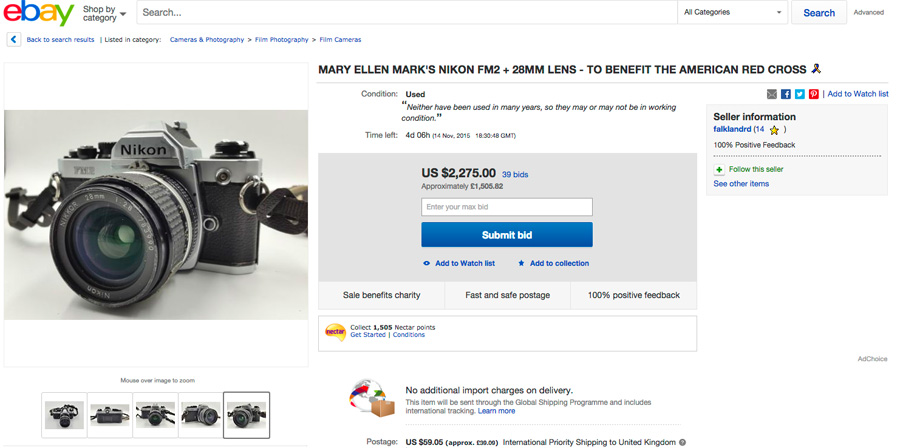On Your Marks for Auction
Remember my post the other week about how it isn’t all about the gear? Well here’s a perfect example of that theory.
I have to confess, I don’t know a huge amount about the work of the American photographer Mary Ellen Mark (she passed away in May of this year), but I knew the name and now know a fair bit more about her since I can across the story (via Petapixel) about one of her cameras going for sale on Ebay. Mary Ellen’s estate has put the camera up for auction partly to raise money for American Red Cross, but presumably also to raise money for themselves.
I don’t know why they want or need to sell it; perhaps they’re looking to dispose of some assets in order to cover death duties and protect her archive. Whatever the full story is, speculation seems a little pointless.
What strikes me though is that if you look through her archive of work and understand that she counted People Magazine and Life Magazine among her clients, the Nikon FM2 (which we’re told she probably used for these clients) is an incredibly basic camera. No whistles, no bells, yet her work is clearly that of someone who could interpret a scene in an engaging way, but with the minimum of camera gear.
That isn’t to say that there aren’t photographers today, with highly sophisticated digital cameras, working in an equally simple but effective way. I know there are, but as I alluded in my earlier post, there is often too much emphasis on camera features and not enough on just getting the technique and style down and telling a good story.
Whether this particular camera has collectible value simply due to its provenance is also an interesting debate to be had. The FM2 was a Japanese, mass-produced camera and you can pick one up on Ebay for less than £200. Bidding on Mary Ellen’s camera has (at the time of writing) already exceeded $2,200.00, so clearly there are interested collectors out there. My instinct tells me her estate view this camera as not central to the story of her work and that her more exotic cameras will remain with them. Again, pure speculation.
Of course whoever buys it will be sorely tempted to put a film through it, assuming it’s still in working order. If it was me I don’t think I could bring myself to do it unless I knew my shots were going to be iconic (I know that’s a bizarre constraint and I can’t really explain it). But then would it be sadder just to place it in a cabinet for display? Well I’m happy to say I can’t match the bids, so that particular quandary won’t be troubling me. If you happen to buy it, do let me know how it goes.


Earlier this year, we visited Shugborough Hall in Staffordshire, Patrick Lichfield’s home. They have set up a display of Lichfield’s work and his office and studio. Obviously, his cameras and the rest of his gear has interest as a part of his story, but one of his cameras on its own would have comparatively little to say as an artifact on its own. Now, if cameras were artisan pierces, each adding their own influence or effect to the finished picture – like rare violins – then owning and using a famous creative’s camera might have some validity as an artistic statement. Otherwise, it’s just celebrity collecting; and unless there was something exceptionally special about a piece of gear – say, that camera of Don McCullin’s that stopped a bullet for him – then even as a collector in other fields myself, I don’t really see the point of it.
I have to agree, Robert. Personally I wouldn’t be so interested in owning a mass-produced camera simply because a famous photographer had owned it. And even Don’s bullet-smashed Nikon would be an odd thing to possess. I did see it in on display when Shaped By War came to Bath, and it was fascinating to see, but not sure I’d want it on my mantlepiece.
Thanks for your insight though, good to hear from you.